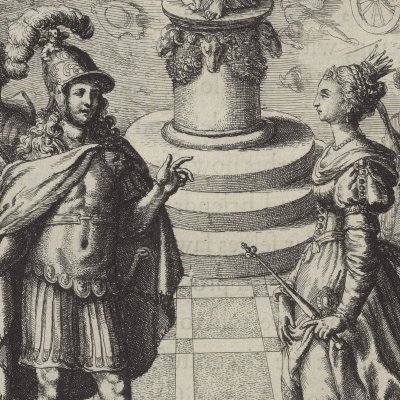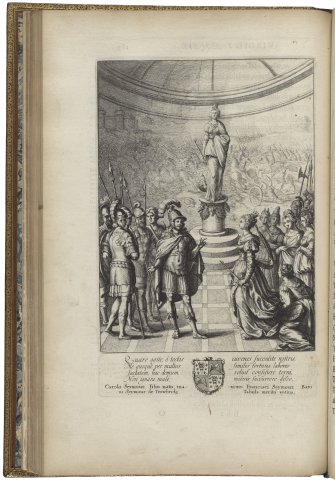Aeneid, Book 1: Dido welcomes Aeneas in front of Juno's temple (The Works of P. Virgilius Maro)
Notice précédente Notice n°25 sur 62 Notice suivante
Description
In the foreground on the left, Aeneas, followed by the Trojans, meets Dido on the right, followed by her court and soldiers. In the background, presiding over this encounter, the statue of Juno, identifiable by the peacock at her feet, dominates the scene. In the background, on the wall of the temple rotunda, a fresco depicts a battle beneath the walls of Troy, whose citadel is visible at the top left. On the right, a young man falls from his chariot; this is Troilus. Above him, a warrior with a drawn sword is about to kill him: this is Achilles.
The illustrator has made a series of condensations:
First, he condensed the two successive episodes of Virgil's narrative, the audience given by Dido to a first group of Trojans, who believe Aeneas to be shipwrecked and lost. Aeneas and Achates attend this audience invisibly, revealing themselves only later, marked by the exchange of two speeches, one by Aeneas and one by Dido. There are no clouds here, and the Trojans are grouped together on the left of the engraving.
Next, the temple is supposed to be decorated with a series of episodes from the Trojan War, according to a principle of compartmentalized representation. The illustrator has combined the succession of images from the ekphrasis into a single battle scene.
Finally, Virgil sets this episode outdoors, in front of the temple. Kleyn places it indoors, imagining a round temple and structuring the stage space accordingly: the stage itself, or restricted space, is marked out on the floor and surrounded by spectators in the circle of the rotunda. The vague space, or stage set, is the fresco on the wall.
The statue of Juno sets the scene. Juno separates the two future lovers and at the same time brings them together: in fact, it is she who persuades Venus to spark a romance between her son Aeneas and Queen Dido, hoping to prevent the fulfillment of his destiny, the founding of a new Troy in Italy.
Dido is supposed to be holding court: she is a queen, addressing unfortunate shipwrecked sailors. But what is depicted here is a diplomatic meeting between two princes of equal rank.
1. The engraving is unsigned.
Caption below the image:
"Quare agite, o tectis iuvenes succedite nostris
Me quoque per multos similis fortuna labores
Iactatam, hac demum voluit consistere terra,
Non ignara mali miseris succurrere disco."
[Come, young men, enter under our roofs.
I too, after being thrown into a thousand trials,
a similar fortune has wanted to settle me on this earth.
Knowing misfortune, I know how to help the unfortunate.]
2. Page 188.
Print dedicated to Charles Seymour, 6th Duke of Somerset, who participated in the subscription.
Technical Data
Notice #018681


